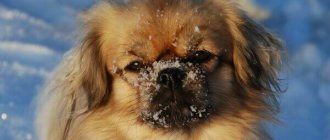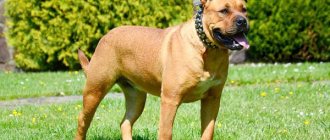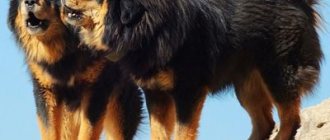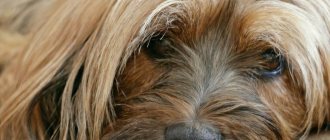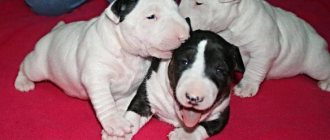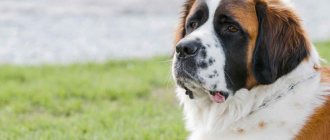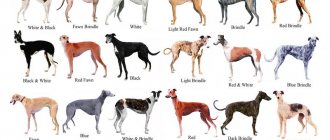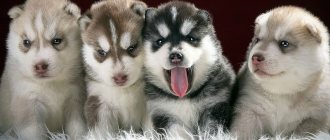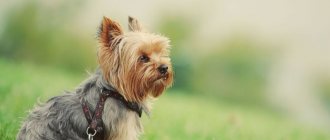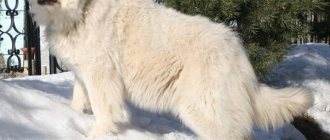Before you get a four-legged pet, you need to carefully study all the characteristics and features of the breed you are interested in. This is extremely important, since dogs have individual characters, sizes, habits, temperaments, preferences and much more. In our article we will talk about the Tibetan Mastiff breed, photos and pictures of which you can see below. This species belongs to the most ancient representatives of watchdogs and was used as an assistant in the protection of monasteries in Tibet and Nepal, and acted as a protector of nomadic families and their livestock from unwanted guests.
Origin story
There is no exact historical data regarding the origin of one of the largest dogs in the world - the Tibetan mastiff. Sources vary greatly in information and facts about the appearance of the breed, and are also embellished with various legends and myths. Some information says that their ancestors are black Himalayan wolves, while others claim that the genus of the Tibetan mastiff came from the guard dogs of Chinese traders who plied the mountains of Tibet. It is known for certain that the first written mentions of shaggy giants date back to 1121 BC. An entry in the Chinese chronicle Shu King says that mastiffs protected the homes of monks, temples and herds of domestic animals from the attacks of predatory snow leopards and from other, no less aggressive inhabitants of the mountains.
Myths and legends, as well as beautiful traditions, say that the first dogs of Tibet belonged to the Buddha himself and the brave Genghis Khan. Dog experts hypothesize that purebred varieties of Tibetan mastiffs are the ancestors of all current breeds of four-legged molossoid species, which includes such famous dogs as St. Bernards, shepherd dogs, Rottweilers, boxers, Great Danes, etc.
The first European notes about the shaggy giant were recorded in 1847. This year, the shaggy puppy was presented as a gift to the English monarch, Queen Victoria. Documented standards for the Tibetan Mastiff breed were recorded in writing in Europe by the Berlin Zoo only in 1898.
Representatives of this species are quite rare and expensive pets. Their value is due to the fact that they were able to preserve their appearance and characteristics almost in their original form. The inaccessible Himalayan mountain range protected the breed from external influence from the southern border, and from the northern border this function was performed by the desert. This contributed to the fact that the appearance of the animals remained original, unchanged and impressive.
Origin
This breed is very ancient, possibly originating in the northern region of the Himalayas centuries BC. Tibetan mountain dogs belong to the Molosser group, descended from older ancestors. In the British Museum there is a 2nd century marble sculpture depicting a Molossian dog, with very short hair along its strong, muscular body and a longer, mane-like coat of hair on its head and neck.
The Romans raised such dogs to participate in the fighting of their army, and also as guards. But even earlier, in the mid-300s BC, the mother of Alexander the Great began to breed them, thanks to which these terrifying huge dogs accompanied her son on military campaigns. The descendants of Molossians became the ancestors of European mastiffs, Rottweilers, Great Danes, some herding and fighting breeds.
Those individuals of Molossian dogs that found themselves in the harsh conditions of the Tibetan highlands laid the foundation for a special breed - the Tibetan Mastiff, which has extreme endurance to frost and is covered with dense, coarse hair with abundant undercoat. These dogs are adapted to sleep buried in the snow, in the open air, even at very low temperatures. They valued loyalty, protective and herding instincts, but never developed fighting qualities.
About the breed
The Tibetan Mastiff is a very large and strong dog with a well-developed muscular physique. Its peculiarity is a long and thick coat with abundant thick undercoat, which creates a kind of mane in the neck and forearm area. This trait gives the breed an amazing resemblance to lions; the animal looks menacing and angry. The dogs are very hardy, they tolerate both cold and hot days well, thanks to which they can safely live outside all year round. The weight of an adult individual ranges from 59 to 85 kg, reaching a height at the withers of 61 – 78 cm.
The characteristics of the Tibetan Mastiff allow it to be used as a companion, guard or even bodyguard. The dogs are smart and well trained, friendly and incredibly loyal to their owner. True, the animal will be able to perform its functions 100% only after reaching adulthood, for boys this is 2-3 years, girls mature only at 4 years. This species has excellent sexual characteristics - males are much larger than females.
Breed Features
Mastiffs are very intelligent and have been guarding livestock for centuries. They know how to make decisions on their own, and sometimes this even interferes with training the puppy. They can be wayward and try to establish their candidacy as a leader.
Important! Attempts to place oneself at the head of the mastiff family must be stopped. Otherwise, you can get a completely uncontrollable huge dog.
An attractive appearance always attracts the attention of others. The animals have a powerful build; a large head with a wide “collar” makes the dog look like a lion. Long hair with dense undercoat predominates throughout the body.
Snow-white Tibetan Mastiffs are a rarity in the breed. They were presented as the most valuable gifts and endowed the animals with unique characteristics. This pet was called nothing less than a “snow lion.”
Dog character
The Tibetan Mastiff's personality has been described as balanced, calm, gentle, friendly and patient. But this is inherent to him only if there are no irritants from outside. When the owner, family or home is threatened, the ability to make decisions, quick reactions and aggression are manifested. The Great Dane perfectly protects the territory entrusted to him and his household from any danger. The breed is one of the highly intelligent representatives of four-legged pets, this is a consequence of the fact that in Tibetan houses it was normal to leave the mastiff in charge of the elder, children and livestock were entrusted to them, the dog itself monitored the maintenance of order.
Dogs of this species perfectly understand their own self and are independent family members who require equal treatment and can sometimes refuse to obey. Along with this, they are very reserved and loyal, they get along well with other dogs and cats, if they are peaceful and do not show arrogance and anger. Tibetan Mastiffs are very warm towards children and can easily become excellent nannies. They are tolerant and perfectly understand their size: if a dog plays with a small child or a person with disabilities, then it will never make awkward movements that could cause injury.
If the pet is used exclusively for security purposes, then it is important to understand that its activity occurs more at night; during the day, shaggy household members are most often drowsy and inactive. It doesn’t have any negative characteristics as such, but everything is individual.
Breed standards
The standards of the Tibetan Mastiff are characterized by many breed indicators and descriptions, these are not only the correct proportions of the body and general appearance, but also temperamental characteristics, color, size and weight.
The main characteristics that define the breed:
- The head is massive, weighty and strong with a large skull, with folds from the tips of the eyes to the edges of the mouth. The frontal part is wide, a tubercle on the back of the head can be easily felt;
- Muzzle with a square end and a blunt edge;
- Powerful jaws with a perfect scissor bite and well-defined lips that completely cover the lower row of teeth;
- The eyes are dark brown, medium-sized, oval-shaped, widely spaced closer to the edges of the head;
- The ears are hanging, medium in size, triangle shaped, slightly covered with soft down. In case of anxiety, they rise;
- The neck has an arched shape, strong structure, with a small dewlap. It is characterized by a long and dense mane-like coat;
- The back is level, the body is large with a well-developed muscular system and a wide, egg-shaped chest;
- The tail is of medium size, lush, smoothly transitions from the dorsal line, has a right or left curl with a beautiful long pile;
- The paws are proportional to the body, massive, and have a regular, even shape.
Weight by month
As mentioned above, in the description of the Tibetan Mastiff breed, dogs do not mature quickly and reach maturity only by 3–4 years. Newborn puppies are born bald with a weight of 400-500 grams, then in the first month of life they gain up to 5 kg and continue at this rate right up to the fourth month, respectively 11 kg for the second month, 15-16 kg for the third and 17-18 kg. fourth. Then there is a weight jump of as much as 7-8 kg and at 5 months the Tibetan Mastiff puppy already weighs 24-25 kg. Over the next seven months, the baby adds 3-4 kg to his body weight and by the age of one year he already weighs 41-44 kg. Every six months following, the four-legged miracle increases by another 5 kg and at two years of age reaches 53-54 kg, respectively. Depending on the feeding ration, each subsequent year the dog gains another 3-4.5 kg and at the peak of its development weighs about 60 kg.
Maximum height and weight
Some specimens of an adult Tibetan mastiff can reach a weight of 88-90 kg and have a height at the withers of up to 80-85 cm.
The largest and most expensive
The Tibetan Mastiff breed is one of the largest in the world and its largest representative, as well as the most famous and expensive, is a male named Big Splash, originally from China. His weight is truly impressive and equals 113 kg. This red baby at 11 months of age already weighed as much as 80 kg. He is also the most valuable dog on the planet and cost his owner $1.5 million. The diet of this pet includes the best varieties of chicken and beef meat, as well as exclusive seafood, which pays off handsomely, since mating with this giant costs more than 15 thousand dollars and the queue for it is impressive.
Description of the breed
According to the FCI classification, the Tibetan Mastiff belongs to the 2nd group of dog breeds “Pinchers and Schnauzers, Molossians, Mountain and Swiss Cattle Dogs”, 2nd section “Molossians”, subsection 2.2. "Mountain Dogs" Working tests are not provided; the functional purpose of the breed is as a watchman and companion.
Exterior
Visually, the Tibetan Great Dane is a large and powerful animal that impresses with its seriousness. A purebred representative is characterized by the following features:
- A large and heavy head with a rounded skull and a clearly defined stop (the transition from the forehead to the back of the nose). The muzzle is wide with a square end. It is desirable that the length of the skull is equal to the length of the muzzle, but a slight change in proportion is allowed when the skull is slightly larger.
- The nose is wide, with well-opened nostrils. The color depends on the coat color, but should be as dark as possible.
- The jaws are strong with a full set of teeth in a scissor bite (with the upper row of incisors overlapping the lower one).
- The eyes are medium in size, oval, located slightly obliquely. The color is allowed in any shade of brown, but the darker the better.
- The ears are triangular and medium in size. From the base they descend forward and hang close to the head.
- The body as a whole is strong, with a developed muscle corset. The neck is muscular, covered with a thick mane (it is more pronounced in males), the back is straight, and the chest is deep and wide (reaches to the level of the elbows).
- The tail is medium in length, thick, set high and carried over the back.
- The forelimbs are straight with muscular shoulders and powerful bones. The hindquarters are parallel to each other, with pronounced angles at the knee and hock joints. The paws are large, rounded, with tightly packed toes.
The Tibetan Mastiff has a well-pigmented dark nose and drooping ears.
In terms of size, representatives of the breed belong to the large category. Males at the withers must be at least 66 cm, and females - 61 cm. Weight is not limited by the standard, but usually the Tibetan mastiff weighs 60–80 kg. The combination of size and body constitution ensures a powerful, stable and free gait. When walking quickly, the breed has a tendency to place its paws in one line.
The fur of Tibetan mastiffs is one of their most important decorations. It is straight, hard and long, with a thick undercoat that is soft to the touch. The tail and neck should be more pubescent, and the hairs themselves in these areas should be longer.
The density of a dog's undercoat depends on the time of year and the climatic conditions of the region - the colder it is, the thicker it will be.
Several color options are allowed:
- black;
- brown;
- gray (blue).
The colors of Tibetan mastiffs are varied, one of them is brown
All colors are allowed both in pure form and with tan marks in shades from gold to red. White markings may be present on the chest and paws, and the undercoat may be lighter than the dog's base color.
Character and psyche of the breed
Representatives of the breed have an independent character, but they are respectful of their owner and obediently carry out his rooms. These are calm, reserved dogs. Since they were bred for protection, most mastiffs prefer to sleep during the day and stay awake at night and perform their duty. They become strongly attached to their family and their territory, boldly defending them if necessary.
In relations with their relatives, do-kui are friendly, but within the limits of reason - if they show aggression towards them, the attacker will receive a rebuff adequate to their behavior. In relation to other pets, representatives of the breed are indifferent, do not offend, but usually do not get involved in active relationships. But Tibetan mastiffs love children very much; they are ready to play for hours, which makes the breed an excellent option for family keeping.
The Tibetan Mastiff is a breed exclusively for the experienced dog breeder. The dog requires a confident owner who will raise the animal consistently and firmly, but at the same time showing his love and care. The main difficulty in raising him is his proud and independent character; a large pet loves to do everything his own way. Therefore, it is extremely important that a person can control his mood and state his demands clearly and strictly.
Mastiffs do not like to be alone. If the owner leaves his pet alone for a long time, then upon returning he may find traces of the dog’s dissatisfaction at home - chewed furniture, digging holes, torn pillows, etc.
Disqualities and disadvantages
Any deviation from the requirements of the official standard is already a minus. The following are recognized as serious shortcomings:
- lack of visual power of the animal;
- pronounced height (disproportionately tall dogs);
- large or low-set ears;
- light eyes;
- poor pigmentation, in particular of the nose;
- barrel ribs;
- a ponytail that is too tightly curled;
- heavy and constricted movement;
- deviation from the minimum height up to 2 cm.
A representative of a breed may be excluded from breeding and participation in exhibitions due to the following problems:
- unreasonably aggressive behavior or excessive shyness;
- demonstration of any physical abnormalities;
- unacceptable color according to the standard.
Appearance from photo
As stated above, this is a huge and muscular breed. Pupils of the Tibetan Mastiff, whose height at the withers reaches 68-78 cm, have a luxurious, voluminous, thick coat with a warm undercoat, which can be seen in the photographs and pictures below.
Coat type and color
The coat of this type of mastiff is unique in its appearance and composition - an abundant elongated pile with a very thick undercoat allows the animals to feel good in the harshest winter conditions, they sleep peacefully in the snow and tolerate icy mountain winds well. As described above, in the neck area the hair has a special length and visually resembles the mane of a lion.
The color of Tibetans is varied and is represented by the following options:
- Black;
- Ginger;
- Brown with iridescence;
- Golden;
- Red;
- Fiery;
- Fiery red;
- Red-orange;
- Chestnut, different shades of gray and blue.
There may also be combined colors with tan inserts in the eye area, on the tip of the tail and all paws.
Is there such a thing as white?
A very rare occurrence is the birth of a white mastiff puppy, which you can see in the photo below. Due to the enormous difficulty of breeding this color, white color is not accepted as a standard. The white Tibetan is a very expensive dog, it looks gorgeous, its cost is estimated at 1 million dollars or more.
Proper care and maintenance
Caring for furry babies and big giants is no different from caring for standard dogs, but requires some nuances, which will be discussed. You can keep such red babies nearby both indoors and outdoors, but the second option is most preferable.
Shedding
Tibetan mastiffs do not shed frequently; this phenomenon occurs once every 365 days. In some natural zones, molting is completely absent. But when the shedding period begins, the hair falls out in clumps, which is a feature of the breed. Despite this, caring for your pet’s fur is quite simple. Caring for them can be compared to caring for shaggy German Shepherds. You only need to comb the soft undercoat a couple of times a week and give vitamins for the lint. As soon as the shedding has passed, fur care is reduced to once every seven days.
Nutrition of the Tibetan Mastiff
The diet of the Tibetan Mastiff is practically no different from the diet of other large dogs. However, the breed has a distinctive feature that the owner must know about. At any age, a pet can refuse food for 4-5 days. There is no need to be afraid of this. It is simply convenient for the dog to eat in this mode. And if the dog is active and looks healthy, then there is no need to panic and run to the veterinarian.
The main diet of a Tibetan Shepherd should consist of the following products:
- lamb or beef, raw or boiled;
- vegetables and fruits;
- fermented milk products;
- porridge;
- eggs and sea fish.
Vitamins and minerals must be added.
You can feed mastiffs with special dry food , while observing the following rules:
- You cannot overfeed your dog.
- Only feeds that are appropriate for the age are used.
- Do not soak dry food in milk or broth.
Once you have chosen the right food for your pet, you should stick to it. Constantly changing types of feed is not recommended.
Breeding: heat, how many puppies does she give birth to?
The first menstrual cycle in a female dog occurs at eight months of age and is repeated once a year, most often in late autumn. The animal's immunity weakens, and it requires special attention and care: the fur should not be allowed to get wet and hypothermia. The first mating can be done only at more than two years of age. The gestation period usually lasts between 54 and 66 days. At this time, the dog is especially aggressive and only allows its owners to approach it. Childbirth is slow. In one litter, the bitch produces offspring of 5-12 cubs, which are born almost bald.
Content Features
Proper maintenance of a Tibetan is the key to his health and long life.
- It is necessary to arrange for the animal its own resting place, where it can freely stretch out while lying down. The ideal is street maintenance with free movement around the territory. Mastiffs do not tolerate being kept on a leash.
- Thick coat requires regular brushing. The pet needs to periodically examine its ears, teeth, eyes and, if necessary, clean them. Nails are trimmed 3 times a month.
- The Tsang-Khi love water. They are bathed 2-3 times a year and given the opportunity to swim independently in the pond.
- Tibetans are unpretentious when it comes to food and eat only 200-300 grams of food at a time.
- The giants have excellent health. To prevent ticks, they are treated with drops in the spring and summer (once a month), deworming is carried out 3 times a year.
Can you keep it on a chain?
Under no circumstances should this breed be kept on a leash. Constant keeping in an enclosure is also contraindicated; it should be closed there only when absolutely necessary, when strangers are in the house. The cage for the Tibetan Mastiff is made spacious and strong; it is not recommended to install a thin wire mesh or chain link.
If a Tibetan dog is left to roam in the yard, the fencing system should be of an appropriate height.
How many times should I wash and comb?
Bathing procedures for the Tibetan Mastiff should be carried out as needed, but it is recommended at least once a quarter. This is explained by the fact that despite the dense wool, household members of this breed practically do not have any unpleasant odor. After washing, the animal must be combed and dried with a hairdryer, the air flow of which must be directed against the growth of the pile. This is necessary in order to achieve maximum fur fluffiness. Tibetans are combed one to three times a week, depending on the condition of the coat.
How to cut your hair?
There are no special features of the haircut process. A hygienic haircut is desirable, but not required. It is needed when there are fur tangles in the wool that cannot be sorted out or combed out. Decorative or seasonal haircuts are carried out solely at the discretion of the owners. The only requirement is not to cut the hair too short, as the animal may catch a cold and get pneumonia. Ideas for haircuts for Tibetan dogs can be found in photos in pet catalogs or animal hairdressing salons.
How to feed correctly and how often?
A very small puppy is fed 6 times a week in small portions.
From 3-4 months, the pet is transferred to 5 meals a day and the portions are slightly increased.
At 6 months the baby can be fed 3 times.
At 8 months the pet eats 2 times a day. In this case, the volume of portions should correspond to the norm for an adult dog.
Menu for the week
Monday:
- Breakfast - cottage cheese or yogurt.
- Lunch – buckwheat with a piece of beef.
- Dinner – boiled fish with cabbage.
Tuesday:
- Breakfast – cottage cheese or kefir.
- Lunch – chicken with carrots, egg.
- Dinner – boiled veal with cabbage or beets.
Wednesday:
- Breakfast - meat broth and egg.
- Lunch – oatmeal with a piece of turkey.
- Dinner – boiled carrots with veal.
Thursday:
- Breakfast – cottage cheese or yogurt.
- Lunch – rice porridge with turkey.
- Dinner – oatmeal with a piece of fish.
Friday:
- Breakfast – chicken broth, egg.
- Lunch - buckwheat with boiled veal.
- Dinner – a piece of chicken with boiled carrots.
Saturday:
- Breakfast – boiled fish with cabbage.
- Lunch – oatmeal with a piece of veal.
- Dinner – chicken broth, stewed beets.
Sunday:
- Breakfast - sour milk, yogurt or cottage cheese.
- Lunch – buckwheat porridge with scalded liver.
- Dinner – stewed cabbage with fish
TM puppies are large and big-boned . Therefore, they need a large amount of calcium-containing foods to prevent rickets.
Training and education
Tibetan Mastiffs and humans get along well, but the breed is sometimes difficult to train at home. Expert breeders recommend sending puppies to canine centers to undergo an obedience course. Training begins with mastering simple commands, such as “Ugh!”, “Lie down!”, “Come to me!”, “Near!” etc. In the first year of life, skills are trained according to commands, and in subsequent years they are consolidated and endurance is developed.
A Tibetan is a student who requires respectful treatment, and not just giving commands. First of all, he is a friend, not a servant, and it is important to understand this.
Health and life expectancy
Shaggy fire giants are naturally endowed with excellent health and long life. The average lifespan of a four-legged pet ranges from 13-15 years, but there are also long-livers, albeit under proper living conditions. Due to their large size, dogs are prone to ailments of the paw joints, so an annual X-ray examination is recommended.
Diseases of the breed
As mentioned above, animals of this breed are distinguished by endurance and good health, but still, like all living beings, they are characterized by some diseases:
- Dysplasia of the pelvic and hip joints;
- Allergic reactions;
- Diseases of weak bones and bone tissue;
- Malignant tumors;
- Dermatitis and osteochondritis;
- Rabies, plague and hepatitis of infectious origin.
Timely vaccination will avoid most illnesses and protect the giant’s immune system for many years.
Important! Systematically take your household member to the veterinary clinic for a routine medical examination and the doctor will always be able to identify early symptoms of disease and prescribe adequate and timely treatment.
Diet and feeding rules
In order for your four-legged friend to lead an active lifestyle and feel good, you need to properly organize his nutrition. This breed of dog is not at all picky about food and eats relatively little.
For purebred puppies, an excellent diet will be beef or horse meat, raw and boiled, heat-treated offal, vegetables, a variety of cereals, milk and fermented milk products (cheeses, kefir, cheese).
Adults are fed beef and veal, seafood, bird eggs and the same set of products that are used for puppies.
It is necessary to ensure that the animal always has clean water and food includes the required amount of vitamins and microelements. If you use food, then choose only trusted manufacturers and those that are specifically intended for the Tibetan Mastiff breed.
Breeders' advice for buying a puppy
Buying a puppy is a very serious step that needs to be approached with full responsibility. You need to choose a baby endowed with excellent physical health. If you don’t have any special wishes for external characteristics, then buy the fastest, most well-fed and strong puppy from the litter. It is important to understand that female individuals will be much smaller than male representatives. The color can be chosen from personal preferences; the color range is represented by a wide choice, from red to gray and even blue shades.
A Tibetan Mastiff puppy, endowed with all the attributes of the breed, must have thick and at the same time fluffy hair with an excellent layer of undercoat. The purchased baby must have clear and healthy eyes, with no signs of illness or disease.
Vaccination schedule
Approximate vaccination schedule for a Tibetan mastiff puppy:
| Puppy age in months | Vaccine used |
| 2 | Nobivac PUPPY DP is a complex live vaccine against plague, parainfluenza, enteritis, leptospirosis and hepatitis. |
| 4-6 (after complete change of teeth) | Nobivac DHPPi+ L is a vaccine against the same diseases. |
| 9-12 | Nobivac DHPPi+ L plus Nobivac R (rabies vaccine). |
In the future, such a vaccine is carried out annually throughout the dog’s life.
Nicknames for boys and girls: what to call
The very name “Tibetan Mastiff” emanates oriental notes, and therefore nicknames with an oriental slant are more suitable for representatives of this breed. But still, the owner himself gives the name to his pet, relying entirely on his own discretion; there are no clear rules in this matter. For those who are scratching their heads and don’t know what to name their household, we have selected the following lists of names:
For boys: Weiming, Liu, Bingwei, Enlei, Guangli, Cheng, Rong, Zen, Bei, Xin, Kiang, Shining; For girls: Yanlin, Zhu, Ting, Lijuan, Luli, Yubi, Rou, Peizhi, Bo, Meili, Shihong, Tao, Bao, Chuntao.
How much does a puppy cost?
As mentioned above, puppies of the Tibetan Mastiff breed are today the highest paid dogs in the world and not everyone can afford to buy one. In each country, the price of a baby varies and depends on many indicators. So they are the most valuable in their homeland; in China, such a purebred miracle costs from 25 to 35 thousand dollars. The European price tag falls much lower and reaches 1-5 thousand dollars. The Russian price range ranges from 40-160 thousand rubles per crumb. In any country, breeders are willing to pay fabulous sums for a rare specimen. Thus, the most expensive exclusive Tibetan Mastiff puppies cost about 1.5 million dollars and more.
Breed characteristics and character traits
At first glance, dogs of the Tibetan Mastiff breed amaze with their size, powerful build, and luxurious coat. This giant will delight you with its calmness and inner confidence. Dogs are self-sufficient and do not impose their love. But they are selflessly devoted to the family in which they live.
In their homeland, mastiffs guarded herds and territory, the owner’s home. Since attacks on property usually occur at night, tailed guards often doze during the day and are awake at night.
At home, Tibetan mastiffs lead a territorial lifestyle, working as shepherds, watchmen and security guards. Despite its somewhat phlegmatic behavior, in case of aggression towards a “pack member” the dog will react instantly.
Each member of the family that takes care of the Tibetan Mastiff can feel completely safe with him from hooligans and bullies. They are distrustful of strangers, but are not the first to show aggression.
Children in the family can do whatever they want with this giant thing - the dog’s patience as a nanny is limitless.
Mastiffs are very sensitive to the psychological atmosphere in the family. They really don’t like scandals, quarrels, unnecessary shouting.
Security Guard and Friend
The dog loves the owner, but will not “bend under” him; only respect for the leader will force him to follow commands. Tibetans are restrained in expressing feelings and will not “hang” on the owner, showing their joy. The maximum that he will do is come up and wait for affection and a kind word.
The intelligence of dogs is very high, they cannot be treated like a stupid dog. Mastiffs must be raised from childhood, without any violence. The dog must understand that there is an owner - a leader who respects and values him highly.
Owner reviews
Having studied the reviews of breeders and canine breeders of furry giants, it turned out that most of them are inclined to the following conclusions:
- Natives of the breed are characterized by excessive distrust of strangers and the absence of any aggression towards their family members;
- They are characterized by restraint, poise, high intelligence, calmness and the ability to protect the objects entrusted to them and their owners;
- The shaggy giant is moderately evil and uses aggression in exceptional situations;
- Such animals do not attack without certain reasons; they are quite friendly with children, as well as with other four-legged household members;
- They can become everyone's favorites in both small and large families.
No negative qualities have been noticed in these dogs, except perhaps excessive stubbornness, and this disappears with proper upbringing.
Interesting to know! The Tibetan Mastiff is not just a guard dog, it is a friend and a full-fledged family member who participates in all household chores and perfectly captures the mood of each member of the household.
